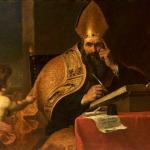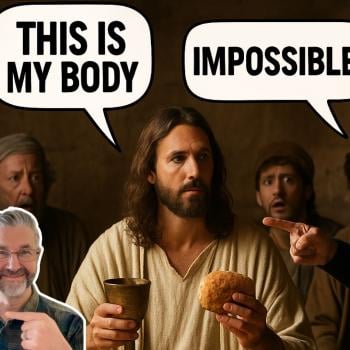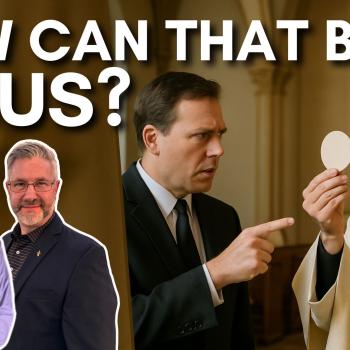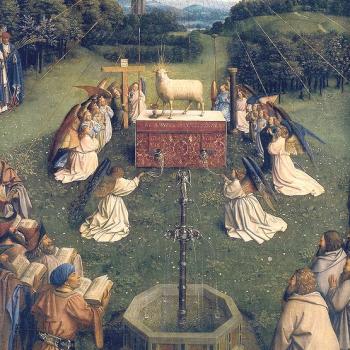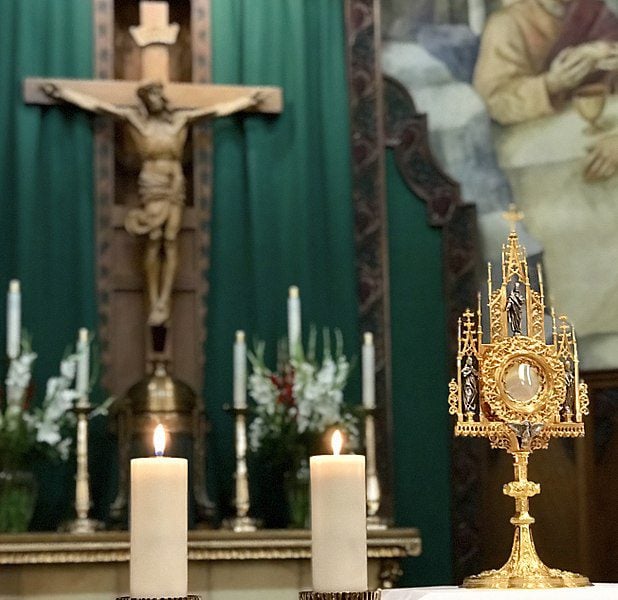
This is material from the original version of my book, A Biblical Defense of Catholicism. This early edition (completed in 1994, and written from late 1990, right after my conversion) was much longer (about 750 pages) and contained many more citations from others. It was a sort of compendium of previous apologetics on all the subjects that it touched upon (somewhat similar in format to Josh McDowell’s Evidence That Demands a Verdict), as well as an extended biblical argument for Catholicism (the portion that later became the bulk of material in my present version). I think it contains some valuable apologetic information. Enjoy!
Bibliographic note: the first number referred to in parentheses following a citation is to a book, as listed in my original bibliography, followed by the page number(s) in the book. Rather than change all these (it’s enough work just cutting-and-pasting all this), I simply list the sources with their original identifying number. Numbers 1-10 in parentheses refer to separate footnotes.
*****
I. INTRODUCTION / DEFINITIONS
1. The Eucharist
Servant of God John A. Hardon, S. J.
“The true Body and Blood of Jesus Christ, who is really and substantially present under the appearances of bread and wine, in order to offer himself in the Sacrifice of the Mass and to be received as spiritual food in Holy Communion. It is called Eucharist, or `thanksgiving,’ because at its institution at the Last Supper Christ `gave thanks,’ and by this fact it is the supreme object and act of Christian gratitude to God . . . As Real Presence, the Eucharist is Christ in his abiding existence on earth today; as Sacrifice; it is Christ in his abiding action of High Priest, continuing now to communicate the graces he merited on Calvary; and as Communion, it is Christ coming to enlighten and strengthen the believer by nourishing his soul for eternal life.” (16:132-133)
2. Real Presence
Servant of God John A. Hardon, S. J.
“The manner of Christ’s presence in the Holy Eucharist. In its definition on the subject, the Council of Trent in 1551 declared that `in the sacrament of the most holy Holy Eucharist is contained truly, really, and substantially the body and blood, together with the soul and divinity, of our Lord Jesus Christ, and consequently the whole Christ’ (Denzinger, Handbook of Creeds, 1854, 1636, 1640) . Hence Christ is present truly or actually and not only symbolically. He is present really, that is objectively in the Eucharist and not only subjectively in the mind of the believer.” (16:360)
“The Real Presence . . . is the physical presence of Christ in our midst, no less truly than he is now present at the right hand of his Father . . .” (14:465)
Blessed Pope Paul VI
“This presence is called ‘real’ – by which it is not intended to exclude all other types of presence as if they could not be ‘real’ too, but because it is presence in the fullest sense . . . a substantial presence by which Christ, the God-Man, is wholly and entirely present . . . It would therefore be wrong to explain this presence by having recourse to the ‘spiritual’ nature, as it is called, of the glorified body of Christ, which is present everywhere, or by reducing it to a kind of symbolism.” (1)
Karl Adam
“So completely does Jesus disclose Himself to His disciples . . . that He gives Himself to them and enters into them as a personal source of grace. Jesus shares with His disciples His most intimate possession, the most precious thing that He Has, His own self . . . So greatly does Jesus love His Community, that He permeates it . . . with His real Self, God and Man. He enters into a real union of flesh and blood with it, and binds it to His being even as the branch is bound to the vine.” (1:18)
3. Transubstantiation
Servant of God John A. Hardon, S. J.
“The complete change of the substance of bread and wine into the substance of Christ’s body and blood by a validly ordained priest during the consecration at Mass so that only the accidents of bread and wine remain. While the faith behind the term was already believed in apostolic times, the term itself was a later development. With the Eastern Fathers before the sixth century, the favored expression was `metaousiosis,’ `change of being’; the Latin tradition coined the word `transubstantiatio,’ `change of substance,’ which was incorporated into the creed of the 4th Lateran Council in 1215.” (16:438-439)
“There was no dependence on Aristotelian philosophy in the Church’s use of words like `substance’ or `transubstantiation.’ Long before either term had become commonplace in the West, the East spoke regularly of the `ousia’ or being of the bread and wine, which were changed into the `ousia’ or being of Christ.” (14:462)
“There are two kinds of changes which things can naturally undergo. They are called accidental and substantial changes. In accidental change, something remains substantially the same, but its accidental or non-essential properties are transformed. Thus when a block of marble is carved into a statue, the marble remains marble, but its shape and form are changed.
“In a substantial change, the former substance ceases to exist and becomes something else. Thus, when food is eaten, its substance is changed; it becomes part of the organism which consumes the food.
“In transubstantiation there is a unique substantial change. The essence or substance of bread and wine ceases to exist, while the accidents or sensibly perceptible properties of bread and wine remain. This kind of change has no counterpart in nature; it belongs to the supernatural order.
“What actually occurs? The substance of what was bread and wine is replaced by the living Christ. Although the external qualities of bread and wine remain, their substance is no longer on the altar. It is now the whole Christ, divinity and humanity, soul and body, and all the bodily qualities that make Christ, Christ.” (15:161)
Nicholas Russo
“Our belief in the Eucharist resolves itself into three distinct propositions . . . First, that our Lord Jesus Christ . . . is present . . . as really and substantially as He is in heaven; second, that after the words of the consecration . . . the substances of bread and wine cease to exist, the accidents or species thereof only remaining; third, that the whole substance of bread and wine is changed into the body and blood of our Lord. This change is called . . . transubstantiation . . .
“The second implies the first, without necessarily implying the third; and yet the third cannot be admitted without admitting the first and the second . . . but one might deny the second and the third without denying the first, as they do who believe that our Lord co-exists in the Eucharist
with bread and wine.” (88:211-212)
4. John 6
James Cardinal Gibbons
“If the Eucharist were merely commemorative bread and wine, instead of being superior, it would really be inferior to the manna; for the manna was supernatural, heavenly, miraculous food, while bread and wine are a natural, earthly food . . .
“The multitude and the disciples who are listening to Him . . . all understood the import of His language precisely as it is explained by the Catholic Church . . .
“It sometimes happened, indeed, that our Savior was misunderstood by His hearers. On such occasions He always took care to remove from their mind the wrong impression they had formed by stating His meaning in simpler language . . . (Nicodemus . . . John 3:1-15 . . . leaven of the Pharisees . . .Matt. 16:5-12).” (10:237-238)
Servant of God John A. Hardon, S. J.
“Jesus was fully aware that his followers were complaining and, in fact, asked them, `Does this upset you?’ But he took nothing back . . . Then, to make absolutely certain there was no mistaking what he was saying, Jesus said the the twelve, `What about you, do you want to go away too?'” (14:459)
Nicholas Russo
“The phrases `to eat the flesh’ and `to drink the blood’ of any one, apart from their literal meaning, signified nothing else among the Jews but to do a person a grievous injury . . . (see Ps 27:2; Job 19:22; Micah 3:3; Eccl 4:5).” (88:201)
Let’s examine these four verses:
Psalms 27:2 “The wicked . . . came upon me to eat up my flesh . . .”
Job 19:22 “Why do ye persecute me as God, and are not satisfied with my flesh?”
NEB: ” . . . Have you not had your teeth in me long enough?”
Micah 3:1-3 “. . . Ye princes of the house of Israel . . . who hate the good, and love the evil; who pluck . . . their flesh from off their bones; who also eat the flesh of my people, and flay their skin from off them . . .”
Ecclesiastes 4:5 “The fool foldeth his hands together, and eateth his own flesh.”
“If, therefore, this metaphorical meaning, the only one employed by the Jews, is to be rejected, we must of necessity admit that Our Lord’s words were understood by them literally. A great deal of ingenuity is displayed by those who deny the Real Presence, and endeavor to show that the words cited mean `to believe in Christ; to eat him spiritually by faith.’ To this we reply: First, the meaning of words is to be determined by the usage existing at the time they are employed . . . But this metaphorical sense was invented centuries afterwards, by men who were bent upon denying the Real Presence, which many generations of Christians had accepted in their belief . . .
“Could an eternal punishment be promulgated for the neglect of that which the Jews refused to believe, if they had not understood what it was they were to believe? . . . If our Lord did not disabuse His hearers, what else can we say but that there was no call to disabuse them, and this precisely because they had understood Him correctly?” (88:201-202,205)
Leslie Rumble and Charles Carty
“The last words of Christ say, `It is the Spirit that gives life. The flesh profiteth nothing’ (Jn 6:64). Christ is not speaking of His Body . . . but of you. You have not the true spirit of God in you, but you let your earthly and natural reason create foolish obstacles. You judge as the natural and animal man, who, according to St. Paul, does not perceive the things of God. Have true faith, and you will understand even though you do not fully comprehend this wonderful promise of Christ . . .
“Unless the words of Christ are taken in the literal sense and at their face value they become meaningless, incoherent and worse than that, Christ would be, then, an arch-deceiver . . .
*
“Christ also said, `I am the door. I am the vine.’ . . . There is no parallel between those two cases. `I am the door’ can have a metaphorical sense. For Christ is like a door, since I go to Heaven through Him; He is like a vine, because all the sap of my spiritual life comes through Him. But the bread is in no way like His Body or His Flesh. Either it is changed into His actual Body, or the expression `This is My Body’ is nonsense. It is misery that God should have to force a Gift upon you, which you should accept with deep faith, gratitude, and love . . .
“When Christ promised that He would give His very Flesh to eat, the Jews protested because they imagined a natural and cannibalistic eating of Christ’s Body. Christ refuted this notion . . . by saying that He would ascend into Heaven, not leaving His Body in its human form upon earth. But He did not say that they were not to eat His actual Body . . . He meant, therefore, `You will not be asked to eat My Flesh in the horrible and natural way you think, for My Body as you see it with your eyes will be gone from this earth. Yet I shall leave My Flesh and Blood in another and supernatural way which your natural and carnal minds cannot understand. The carnal or fleshly judgment profits nothing. I ask you, therefore, to have faith in Me and to trust Me. It is the spirit of faith which will enable you to believe, not your natural judgment.’ Then the Gospel goes on to say that many would not believe, and walked no more with Him; just as many today will not believe, and walk no more with the Catholic Church.” (3)
Bertrand Conway
“Catholics make a distinction between the first part of John 6 (verses 26 to 51), wherein Christ speaks of Himself figuratively as the Bread of Heaven, a spiritual food to be received by faith. and the second part (verses 51 to 59), wherein He speaks literally of His Flesh and Blood as a real food, and a real drink. `In the first part,’ writes Atzberger, `the food is of the present, in the second of the future; there it is given by the Father, here by the Redeemer Himself; there it is simply called `bread,’ here the `Flesh of the Son of Man’; there our Lord speaks only of bread, here of His Flesh and Blood’ . . .(Handbuch der Kath. Dogmatik, iv, 569) . . .
“Christ makes a clear-cut distinction between three kinds of breads the bread or manna of the desert (Ex 16:15; Jn 6:49), given by Moses to the Jews in the past to nourish the body; the Bread of Heaven or the Bread of Life (Jn 6:32,35), Christ Himself, given by the Father in the present to the Jews as an object of faith; and the Bread of Life, Christ Himself in the Eucharist, to be given in the future by Christ for the life of the world (Jn 6:52).
“Again, a figurative interpretation is impossible, according to the rules of language. If a figure of speech has a definite meaning, we cannot use it in a new sense, merely for purposes of controversy . . .
“To drink one’s blood was also a familiar figure among the Jews, but it always meant a chastisement of God (Is 49:26; Rev 16:6) upon His enemies, a meaning impossible here.” (85:248-249)
Isaiah 49:26 ” . . . I will feed them that oppress thee with their own flesh; and they shall be drunken with their own blood . . .”
Revelation 16:6 ” . . . They have shed the blood of saints and prophets . . . and thou hast given them blood to drink . . .”
“Drinking blood was expressly forbidden by the Jewish law (Gen 4:4; Lev 3:17; 7:26; 19:26; Deut 12:16; 15:23), and was therefore regarded as a heinous crime (I Kings 14:33; . . . Ezek 33:25). Cardinal Wiseman well says: `The ideas of drinking blood and eating human flesh presented something so frightful to a Jew, that we cannot allow our Savior, if a sincere teacher . . . to have used them at all under any circumstances than an absolute necessity of recurring to them, as the most literal method of representing His doctrines’ (Lectures on the Real Presence, 106).
” . . . We must remember that Christ, like every good teacher, made two sorts of answers to men who objected to His teaching. If they did not understand His meaning, He explained His doctrine more fully. In this way He explains . . . the possibility of the rich man being saved (Mt 19: 24-6), the fact of Lazarus’ death (Jn 11:11-14), the idea of freedom (Jn 8:32-4; cf. Jn 4:31-4; 8:21-23). When His hearers understood His teaching but refused to accept it, He repeated His teaching with even more emphasis. Thus, He insisted upon His power to forgive sins, when the Scribes accused Him of blasphemy (Mt 9:2-7), and insisted on His being Eternal, when the Jews said He was not yet fifty years old (Jn 8:56-8).
“In like manner He acted with the Jews who objected to His teaching about the Real Presence . . . He did not explain His doctrine in a figurative sense, but He repeated the doctrine that gave offence in a most emphatic manner (e.g., 6:53,55).” (85:249)
Conway goes on to refute the most common Protestant comeback – that of citing Jn 6:63 to the effect that when Jesus contrasts “spirit” and “flesh,” He is proclaiming the purely symbolic nature of the Eucharist:
“The words flesh and spirit, when opposed to each other in the New Testament, never mean literal and figurative, but always the corrupted dispositions of sinful human nature (flesh) contrasted with human nature enriched by the grace of God (spirit) (Mt 26:41; Rom 7:5-6,25; 8:1-14; I Cor 5:5; II Cor 7:1; Gal 3:3; 4:29; 5:13-26; I Pet 3:18; 4:6). Christ’s meaning, therefore, is clear: My words are such as the mere carnal man cannot receive, but only the man endowed with grace. St. Chrysostom says: `Why, therefore did He say: The flesh profiteth nothing? Not of His flesh does He mean this. Far from it; but of those who would understand what He said in a carnal sense . . . You see, there is question not of His flesh, but of the fleshly way of hearing’ (In Joan., 47,2).” (85:251)
Ludwig Ott
“The necessity of accepting a literal interpretation in this case is . . . evident: A) From the nature of the words used. One specially notes the realistic expressions . . . `true, real food’ (v.55); . . . `true, real drink’ (v.55) / (4); `trogo’ = `to gnaw, to chew, to eat’ (5); B) From the difficulties created by the figurative interpretation . . .; C) From the reactions of the listeners, . . . D) the interpretation of the Fathers.” (13:374)
Ven. Archbishop Fulton Sheen
“As they had communion with the flesh and blood of the Paschal Lamb, so they would now have communion with the Flesh and Blood of the true Lamb of God. He, Who was born in Bethlehem, the `House of Bread’ . . . would now be to men, so inferior to Him, their Bread of Life . . . As man died spiritually by physically eating in the Garden of Eden, so he would live again spiritually through eating the fruit of the Tree of Life.” (6)
Romano Guardini
“Should they have understood? Hardly. It is inconceivable that at any time anyone could have grasped intellectually the meaning of these words. But they should have believed. They should have clung to Christ blindly, wherever he led them. They should have sensed . . . that they were being directed toward something unspeakably huge, and simply said: we do not understand; show us what you mean. Instead they judge, and everything closes to them.” (97:206)
“Jesus’ closest followers are hard-pressed, but He does not help them. He forces them to a decision of life or death; are they ready to accept the fullness of revelation, which necessarily overthrows earthly wisdom, or do they insist on judging revelation, delimiting its `possibilities’ from their own perspective? . . . Jesus turns to the remaining hard core: `Do you also wish to go away?’ . . . Still not a word of help, only the hard, pure demand for a decision . . . They do not understand either, but struck by the power of the mystery, they surrender themselves to it. They are dumbfounded but trustful; at least most of them . . .
“Apparently there is no genuine belief without battle. Every believer worthy of the name must sometime undergo the danger of scandal and its trial by fire . . . It was the shock that probably shattered Judas’ faith, the other eleven saving themselves only by a blind leap of trust to the Master’s feet . . . Here is the steepest, highest pinnacle of our faith (or the narrowest, most precipitous pass through which that faith must labor) . . . faith’s supreme test . . .
“Jesus desires that men receive and make their own the gift of His vital essence, strength, His very Person as fully and intimately as they receive and assimilate the strength and nourishment of bread and wine. He even adds that the person who is not so nourished cannot possess ultimate life.” (98:164-7)
5. The Last Supper
Frank Sheed
“The word `is’ need not detain us. There are those . . . who say that the phrase really means `This represents my body.’ This sounds very close to desperation . . . The word `this’ deserves a closer look. Had He said `Here is My body,’ He might have meant that in some mysterious way, His body was there as well as, along with, the bread. But He said `This is My body’ – this which I am holding, this which looks like bread but is not, this which was bread before I blessed it, this has become My body . . .
“What our Lord was giving us was a union with Himself closer than the apostles had in the three years of their companionship, than Mary Magdalen had when she clung to Him after His resurrection.” (81:200-201)
Servant of God John A. Hardon, S. J.
“Christ . . . would not, in a matter of such paramount importance, have recourse to meaningless and (worse still) deceptive figures of speech. Figures of speech enhance a discourse only when the figurative meaning is clear either from the nature of the case or from common usage, neither of which could be invoked to claim that Christ was talking figuratively at the Last Supper.” (14:460)
Martin Scott
“At the Last Supper He worked His greatest miracle . . . There was no outward change whatever . . . yet on Christ’s word there was a substantial change . . . If we saw the bread transformed into actual flesh before our eyes there would be no mystery of faith. It would be evidence . . . But Christ instituted the Mass as a mystery of faith. He wanted us to believe on His word, even though there was no evidence to support it.” (86:126)
Leslie Rumble and Charles Carty
“At the Last Supper Christ fulfilled what He had promised in the 6th chapter of St. John . . . This is My Body; this is My Blood – what words could be plainer? . . . In the language spoken by Christ there are at least forty expressions which meant `to signify.'” (8)
“Q: `The Apostles must have taken the symbolical sense, for they did not remark on the repugnant sense.’ . . . A: At the Last Supper it is far more likely that the Apostles would have remarked upon our Lord’s words if He had meant them symbolically . . . There were many other alternative expressions . . . If Christ intended to give merely a symbol of His body . . . He chose the very worst words to convey His meaning when He said without any qualification, `This is My body.’ It was so unnecessary to choose that expression, and so absurd, that the Apostles would certainly have demanded an explanation of what He meant. But they did not.” (83; v.2:769)
James Cardinal Gibbons
“According to a common rule observed in the interpretation of the Holy Scripture, we must always take the words in their literal signification, unless we have some special reason which obliges us to accept them in a figurative meaning.” (10:240)
Bertrand Conway
“I may refer to a man’s cunning by calling him a fox . . . Again, I may hold in my hand a photograph of the President of the United States, and say: `This is Mr. Hoover.’ In both instances my meaning will be evident at once. But in no way is bread the fitting or possible symbol of the human body . . . Would Christ . . . use a figure of speech that would deceive millions of His followers for all time, and lead them into the very idolatry He came to abolish?” (85:252)
Ludwig Ott
“The necessity of interpreting the words literally may be seen: A) By the wording. There is nothing in the text to support a figurative interpretation; for bread and wine are neither of their nature, nor by current speech-usage, symbols of body and blood. The literal interpretation involves no intrinsic contradiction though it presupposes faith in the Divinity of Christ. B) By the circumstances . . . In order to avoid the danger of misleading humanity, in the institution of such a sublime Sacrament and act of worship . . . He had to employ a form of speech which could not be mistaken. C) By the practical inferences which St. Paul draws from the words of institution. In the unworthy reception of the Eucharist the Apostle sees a sinning against the body and blood of Our Lord . . . I Cor 11: 27 ff.; I Cor 10:16 . . . D) By the inadequacy of the arguments advanced against it. When the copula `Is’ in many passages of Holy Writ has the meaning of `designates’ or `symbolises,’ the figurative sense of those passages is apparent at once from the nature of the matter (for example Mt 13 : 38 : `The field is the world’; cf. Jn 10:7; 15:1; I Cor 10:4) . . . (or) in a Parable or an allegory, or from the current use of language.” (13:375)
Romano Guardini
“Here on the same table the sacrificial lamb had lain . . . Those present cannot fail to understand Jesus’ words in the same sense: ritualistically and mysteriously, but realistically nevertheless . . . They did not interpret it merely as a symbol . . . but rather along the lines of the first passover in Egypt, of the paschal feast they had just completed, and of the sacrificial rite celebrated day after day in their temples.” (98:370)
6. St. Paul
Ronald Cox
“In contrasting the Blessed Eucharist to pagan and Jewish sacrifices, Paul quite clearly assumes that the Mass is a true sacrifice. He also teaches that Communion means union with each other through our common union with Christ; it is the sacrament of unity in the Mystical Body. Christians at Corinth and at Ephesus all eat of the one same bread; an impossibility unless the bread has been changed into the body of Christ.” (9)
Alan Schreck
“The most straightforward interpretation of these passages is that Paul considered the eucharistic bread and wine to be literally the body and blood of Christ.” (2:130)
James Cardinal Gibbons
“Could St. Paul express more clearly his belief in the Real Presence than he has done here? . . . He who receives a Sacrament unworthily shall be guilty of the sin of high treason, and of shedding the blood of his Lord in vain. But how could he be guilty of a crime so enormous if he had taken in the Eucharist only a particle of bread and wine? Would a man be accused of homicide . . . if he were to offer violence to the statue or painting of the governor? Certainly not. In like manner, St. Paul would not . . . declare a man guilty of trampling on the blood of his Savior by drinking in an unworthy manner a little wine in memory of him.” (10:242-243)
Ronald Cox
“Paul reminds them of the sacredness of the act they perform at Mass by identifying it with both the Last Supper and the Crucifixion . . . Though different in manner, it is really the sacrificial death of Christ on the cross that is commemorated at each Mass.” (10)
7. Protestant Symbolic Views and Their Precursors
Docetism and Gnosticism
“In Christian antiquity the Docetae and the Gnostic-manichaean sects, starting from the assumption that Christ had only an apparent body, denied the real presence.” (13:371)
Ratramnus
“The first serious ripples of controversy came in the 9th century . . . A monk from the French Abbey of Corbie . . . Ratramnus (d.868) held that Christ’s body in the Eucharist cannot be the same as Christ’s historical body once on earth and now in heaven because the Eucharistic body is invisible, impalpable and spiritual. He wanted to hold on to the Real Presence but stressed the Eucharist as symbolic rather than corporeal . . . His ideas . . . influenced all subsequent theories that contradicted the traditional teaching of the Church.” (14:461)
Berengarius
“Berengarius of Tours (d.1088) denied the Transubstantiation . . . He saw in the Eucharist merely a figure of the body and blood of Christ . . . In 1079, . . . Berengarius made a revocation.” (13:371-372)
Catharism and Albigensianism
“In the 12th and 13th centuries various spiritualistic sects, out of aversion to the visible organisation of the Church, and under the influence of Gnostic-manichaean views, denied the sacerdotal power of consecration and the Real Presence ( . . . Cathari, Albigenses). In refutation of these errors, the 4th Lateran Council (1215) officially proposed the doctrines of Transubstantiation, of the Real Presence; and of the exclusive consecration-power of the validly consecrated priest.” (13:372)
John Wycliffe
“In the 14th century John Wycliffe (d.1384) . . . taught that the substances of the bread and wine remain after the consecration (Remanance theory). He reduced the presence of Christ in the Eucharist to a dynamic presence . . . [and] that the adoration of the Eucharist is idolatry, and that the Mass was not instituted by Christ. His teaching was rejected at . . . the Council of Constance (1418).” (13:372)
Bibliography
1. Karl Adam, The Spirit of Catholicism, translated by JustinMcCann, revised edition, Garden City, New York: Doubleday Image, 1954 (orig. 1924).
2. Alan Schreck, Catholic and Christian, Ann Arbor, Michigan: Servant Books, 1984.
10. James Cardinal Gibbons, The Faith of Our Fathers, New York: P. J. Kenedy & Sons, rev. ed., 1917.
13. Ludwig Ott, Fundamentals of Catholic Dogma, Rockford, Illinois: TAN Books, 1974.
14. Servant of God John A. Hardon, S. J., The Catholic Catechism, Garden City, New York: Doubleday, 1975.
15. Servant of God John A. Hardon, S. J., Pocket Catholic Catechism, New York: Doubleday Image, 1989.
16. Servant of God John A. Hardon, S. J., Pocket Catholic Dictionary, New York: Doubleday Image, 1980.
81. Frank J. Sheed, Theology For Beginners, New York: Sheed & Ward, 1957.
83. Leslie Rumble and Charles M. Carty, Radio Replies, 3 volumes, St. Paul, Minnesota: Radio Replies Press, 1940, 1039 pages [4374 questions about Catholicism answered].
85. Bertrand L. Conway, The Ouestion Box, New York: Paulist Press, 1929.
86. Martin Scott, Things Catholics are Asked About, New York: P. J. Kenedy & Sons, 1927.
88. Nicholas Russo, The True Religion, New York: P. J. Kenedy & Sons, 1886.
97. Romano Guardini, The Lord, translated by Elinor C. Briefs, Chicago: Henry Regnery, 1954.
98. Romano Guardini, Meditations Before Mass, translated by Elinor C. Briefs, Westminster, Maryland: Newman Press, 1955.
Footnotes
1. Blessed Pope Paul VI, Encyclical Mysterium Fidei (“On Eucharistic Doctrine and Worship”), Glen Rock, New Jersey: Paulist Press, September 3, 1965, 42.
2. William Barclay, Daily Study Bible, John, Philadelphia: Westminster Press, vol. 1, revised edition, 1975, 223-225.
3. Leslie Rumble and Charles Carty, Eucharist Quizzes to a Street Preacher, St. Paul, Minnesota: Radio Replies Press / Rep. Rockford, Illinois: TAN Books, 1976, Question numbers 10, 12, 19-20, 29.
4. Greek alethos (“true,” “indeed,” “sure,” or “verily”); Strong’s word #230.
5. Greek trogo: Strong’s word #5176. Thayer’s Greek Lexicon gives the literal meaning as “to gnaw, crunch, chew raw vegetables or fruits (as nuts, almonds, etc.),” p. 631. This word only appears six times in the NT and is always translated as “eat” in the KJV — in John 6:54, 56, 57, 58, and in John 13:18 and Matthew 24:38:
John 13:18 “. . . He that eateth bread with me hath lifted up his heel against me.” (Referring to Judas, in the context of the Last Supper, probably in reference to the meal which was the institution of the Eucharist).
Matt 24:38 “. . . In the days . . . before the flood they were eating and drinking . . .”
6. Venerable Fulton Sheen, Life of Christ, Garden City, New York: Doubleday Image, 1958 / 1977 reprint, 140-141.
7. Joseph Martos, Doors to the Sacred, Garden City, New York: Doubleday, 1981, 241-242.
8. Rumble & Carty, ibid. (#3), numbers 13-14.
9. Ronald Cox, It is Paul Who Writes, New York: Sheed & Ward, 1944, 175.
10. Ibid., 179.
***
(completed on 8 March 1992 / Feast of St. John of God; slightly revised on 26 February 1994)
Photo credit: Transubstantiation – The Real Presence of Jesus in the Eucharistic Adoration at St Thomas Aquinas Cathedral in Reno, Nevada. Photo by TrappistMonkStuff (10-19-17) [Wikimedia Commons / Creative Commons Attribution-Share Alike 4.0 International license]
***



